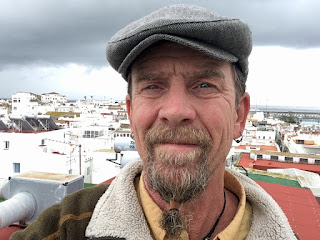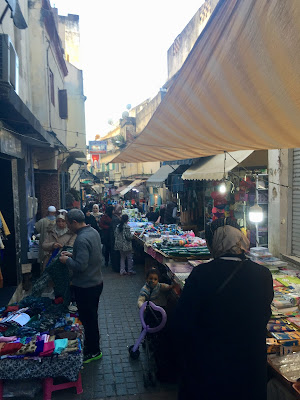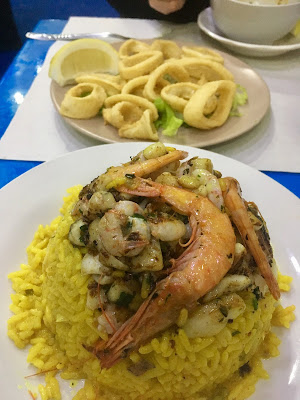My One amongst the Street Market
Sometimes getting lost is its own reward. Sometimes it just leads to sore feet. Not far from our hotel in Tangier, the map showed a tangle of small lanes. The neighborhood is sandwiched between the Boulevard de Fés and Avenue Sidi Mohamed Ben Abdellah. From the map, it looked like the Kasbah without the walled fortifications.
We walked three long city blocks, crossed Boulevard de Fés, and disappeared into a maze. The place was devoid of even the few tourists one sees in the Kasbah. This neighborhood was the real deal. Two quick twists and we found ourselves immersed in a local street market, a noisy shopping street crammed into a lane not twelve feet wide. The place was seething with folks out for an evening of shopping. From tables of bras and underwear to bootleg CDs, piles of dates to piles of shoes, there was very little that wasn't on offer.
Fruit and vegetables were piled high on every side. The entire neighborhood seemed to be out for the evening, slowly threading their way through the stalls. There were rickety tables set up down the center of the lane, with stalls and cramped storefronts on either side. Two people could squeeze through the narrow aisles that remained, but only if they liked each other a lot. It was a case of abandoning ones personal-space bubble and plunging in.
Shopping Tangier-Style
The local folks seemed surprised to see foreigners in this part of town. A smile and a nod were all that was required to receive a warm welcome in return. Trapped in one of the market scrums, I ended up squished against a table full of goods. The stall-keeper held out an arm to steady me. He prevented me from toppling onto his dates and figs, while at the same time giving me a shoulder squeeze and me a big smile.
We strolled the entire market street, moving with the fits and starts of the crowd. I felt that Tangier had yielded up yet another wonderful surprise. This city is a walking city. There is simply no other way to explore the place. With every walkabout and every wrong turn, we found more gems, more hidden treasures. This last evening in Tangier, we were treated to this amazing market in an amazing neighborhood.
Walking is hungry work. We retired to our food street for some local fare. We started out the meal was Harira, our new favorite soup. The other dish is Zaalouk, an eggplant dish. I love foods that start with a 'Z.'
Paella and Calamari to round things out.
Our last night in Tangier found us lounging on the terrace at the Hotel Chellah. Sipping sweet mint tea over the dark garden, we savored the last of another fine day in this crazy city. As much as we love Tangier, it was time to move on.
Breakfast time is Café time in Tangier. Our adopted sidewalk spot was just behind our hotel, a great place to have brekkie and watch the city go to work.
Breakfast in Morocco is a bread feast. Gluten-free folks, abandon all hope. The standard fare is a heavy crepe-like roti, round corn bread, a savory roll, and some flat bread. Add butter, honey, nut paste, and voilá. To drink there is fruit juice and, of course, café au lait. Olives are always there, as they are at every meal.
The cacophony of the Tangier Bus Station.
Shouldering the backpacks, we walked down the hill from Hotel Chellah. Threading our way past the press of shills and touts, we got out luggage tags and found the platform for our bus. The shouts of the touts rang through the station. A stray kitten took refuge behind our bags. Folks milled about as myriad buses came and went. It was the usual frenetic third-world bus station vibe.
On the travel chat boards, much is made of how difficult or confusing it is to get from Tangier to Tétouan or Chechaouen. In actuality, nothing could be simpler. Walk down to the bus station the day before you want to leave. There will be ten shills there, all trying to pull you to one of the various bus company windows. Avoid the shills (easier said than done) and read the schedule boards. When you find something that works, buy the tickets. The next day, show up thirty minutes before your bus leaves. Piece of cake. This is a good Standard Operating Procedure across the world. Reliable online schedules disappear pretty quickly as one gets further away from Europe or North America.
On to Tétouan!
The bus wound its way out of Tangier, heading for the open country east of the city. This has been the wettest (and coldest) spring that folks around here can remember. The hills and fields were a lush green. Herdsmen (and women) were grazing their sheep, goats, cows and horses on the thick grass along the highway. Donkeys bearing laden cargo frames pulled obstinately at their lead ropes.
The Foothills of the Rif Mountains
Our bus climbed the foothills of the Rif Mountains, dropped into valleys, then twisted back up into the mountains. After an hour and a half, the full height of the Rif swam into view. The bus eased into the white-washed town of Tétouan.
Here is where it all went wrong
We were out of the bus station and into the sun-washed streets of Tétouan. The rest of the foriegners had stayed on the bus, bound for the tourist-darling town of Chechaouen. We were going to hide out here, but first we had to find our hotel.
When traveling as a team, it is best to trust the instincts of the entire team, not just one maniac. The maniac (that would be me) was sure that he knew the way to the hotel, a hotel hidden deep in one of the most tangled Medinas of North Africa. So... I screwed the pooch. Big-Time.
Two kilometers later, and far off course, I finally listened to the instincts of My One. She proved to be right, of course. I have an unusually good sense of direction, but when I go wrong, I go spectacularly wrong. Such was the case this day. Then, of course, I had to have a good sulk whilst ceremoniously kicking myself in the ass. I admit that this is childish behavior, and I also admit that I take a perverse pleasure in the process. It is not a great participatory sport, however. My Love tolerated as much as she could, then she found us a good café.
Islamic Cemetery, Tétouan
One of the great things about getting lost, besides the childish fits, is seeing stuff that you would have missed. Granted, it was two kilometers out of the way, and another two back, but we got to see an amazing graveyard.
Goats and Graves!
The main street on which our hotel was located.
Finally, after wandering into the Medina, getting lost, and paying a shill five dirham, we were at the hotel. Another lesson learned. Even with a screen shot of Google Maps, a normally good sense of direction, and an over-supply of good luck, things can go very, very wrong. If your Baby says "I think it's the other way..." at least be open to the possibility.
Looking over the Medina to the Mediterranean Sea
With the room secured and the bags stowed, all was well. We plopped ourselves on the roof-top terrace and enjoyed the afternoon. There will be more from Tétouan, including a brief dissertation on the Touts and Shills. For now, it is time to wait for the Call to Prayer. From Tétouan, Morocco, it is "Ciao for Now!'























































